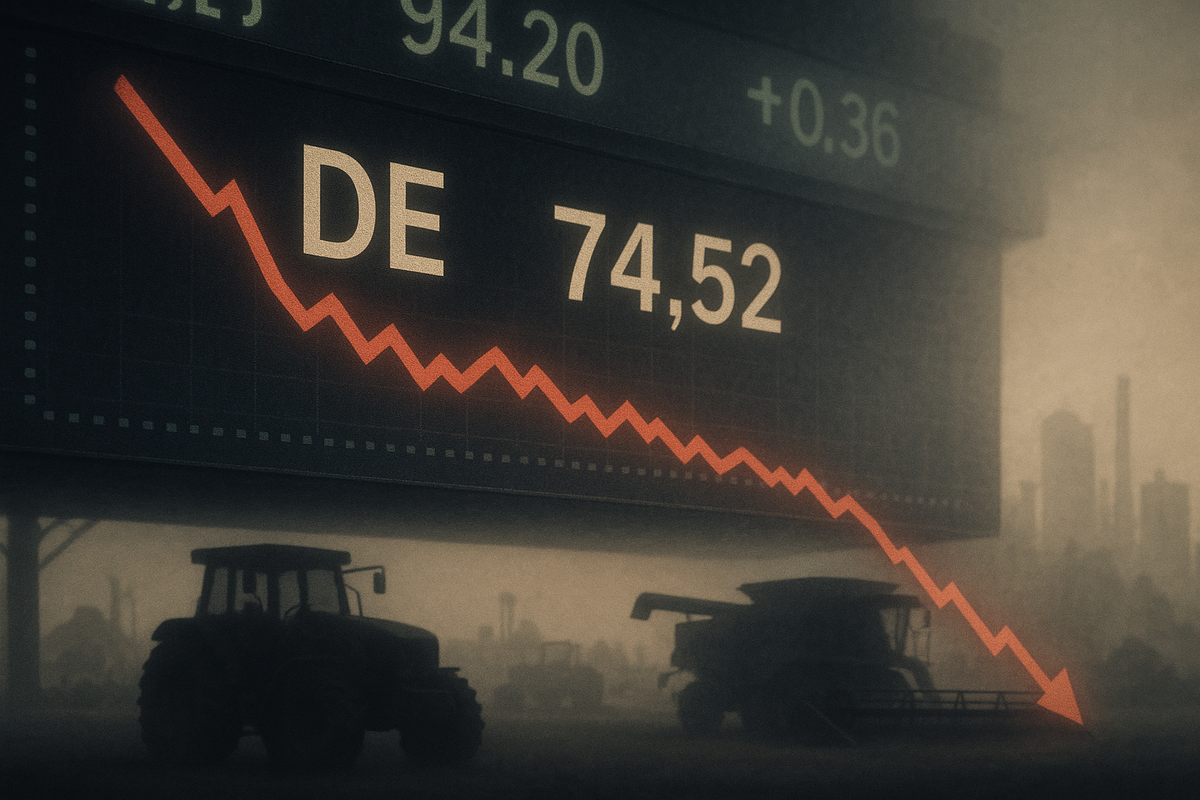
Moline, IL – August 14, 2025 – Shares of agricultural and construction equipment giant Deere & Company (NYSE: DE) experienced a sharp decline today, tumbling nearly 7% after the company announced a reduction in its full-year profit outlook. This significant drop occurred despite Deere reporting better-than-expected quarterly earnings, highlighting investor sensitivity to forward-looking guidance amidst a "challenging" economic environment and increasingly "cautious" customer behavior. The market's immediate reaction underscores growing concerns about the health of the agricultural sector and broader industrial demand.
The unexpected downward revision to Deere's financial projections has sent ripples through the market, signaling potential headwinds for the industrial machinery sector. While the company managed to surpass Wall Street's estimates for its fiscal third quarter, the lowered outlook overshadowed these positive results, prompting a swift and decisive sell-off. This move by Deere suggests that even industry leaders are not immune to the pressures of a tightening economic landscape and shifting customer sentiment, raising questions about the resilience of demand for heavy equipment.
Deere's Forecast Cut: A Deep Dive into Market Discontent
Deere & Company's stock plummeted by nearly 7% on August 14, 2025, a direct consequence of the company's decision to lower the upper end of its full-year profit outlook. This significant revision came despite Deere (NYSE: DE) reporting a robust fiscal third quarter, where it surpassed analyst expectations for both earnings per share (EPS) and revenue. The company now anticipates full-year net income to fall between $4.75 billion and $5.25 billion, a narrower range from the previously projected $4.75 billion to $5.50 billion. This adjustment was attributed to a confluence of factors, including "challenging times" and a noticeable shift towards more cautious spending among its customer base.
The timeline leading up to this moment reveals a gradual build-up of pressure. For several quarters, analysts have been closely monitoring the agricultural sector, noting the impact of fluctuating crop prices and rising input costs on farmer profitability. While Deere had previously maintained a relatively optimistic stance, the latest guidance signals a more conservative outlook, acknowledging the persistent headwinds. Key players involved include Deere's management, who are navigating these economic currents, and investors, who are now recalibrating their expectations for the company's future performance. The initial market reaction was swift and severe, with the stock dropping over 6% in pre-market trading and continuing its descent throughout the day. This immediate plunge underscores the market's prioritization of future guidance over past performance, indicating a deep-seated concern about the sustainability of demand for agricultural and construction equipment.
Further exacerbating the situation are weakening demand and pricing pressures across Deere's core businesses. Sales in production and precision agriculture saw a notable 16% year-over-year decline, while the construction equipment segment experienced its third consecutive quarter of pricing weakness. Even the small agriculture and turf sales were not immune, also registering a decline. A significant contributing factor to the revised outlook and margin compression is the escalating impact of U.S. tariffs. Deere has warned of a larger tariff hit than initially anticipated, with an estimated pre-tax tariff impact of nearly $600 million for the year, a substantial increase from the $500 million projected last quarter. This has directly translated into higher production costs and a dampening effect on demand, particularly within the crucial North American market.
The cautious spending by farmers, driven by lower crop prices for commodities like wheat, corn, and soybeans, has directly impacted Deere's sales volumes. Farmers are increasingly opting for cost-cutting measures, such as renting machinery instead of purchasing new equipment. This subdued spending pattern presents a significant challenge for Deere. Moreover, despite proactive efforts to manage inventory and align production with retail demand, high levels of late-model used equipment persist in the market. This oversupply could further pressure pricing and future sales, creating a challenging environment for the company to offload new inventory. The 7% stock drop has brought Deere's shares near critical technical support levels, prompting investors to weigh whether this presents a buying opportunity or signals a more prolonged bearish trend for the stock.
Shifting Fortunes: Winners and Losers in the Wake of Deere's Downturn
The immediate aftermath of Deere's (NYSE: DE) outlook cut creates a clear delineation of potential winners and losers within the industrial and agricultural machinery sectors. The most apparent "loser" is, of course, Deere itself, as evidenced by the nearly 7% plunge in its stock price. This decline reflects investor apprehension about the company's ability to maintain its growth trajectory in a challenging economic climate. The lowered guidance suggests that Deere may face reduced sales volumes and potentially tighter profit margins in the coming quarters, impacting its overall financial performance and market valuation. Shareholders who held the stock prior to the announcement are experiencing a direct hit to their portfolios.
On the other hand, companies that offer more cost-effective alternatives or services that cater to the "cautious" customer sentiment might emerge as relative "winners." For instance, companies specializing in used equipment sales, equipment rental services, or aftermarket parts and repairs could see increased demand as farmers and construction companies prioritize extending the life of existing machinery over purchasing new units. This shift in spending habits could benefit businesses like Ritchie Bros. Auctioneers (NYSE: RBA), a global leader in industrial auctions, or various regional equipment rental companies that provide flexible solutions without the significant capital outlay of a new purchase. Additionally, companies involved in agricultural technology that can demonstrate clear efficiency gains or cost savings for farmers, rather than requiring large upfront equipment investments, might also find themselves in a more favorable position.
Furthermore, competitors in the agricultural and construction equipment space, while not entirely immune to the broader industry headwinds, might experience a less severe impact or even gain market share if they can demonstrate greater resilience or adaptability. While Caterpillar (NYSE: CAT) also faces production shifts and pricing challenges, its more diversified portfolio, encompassing mining and energy sectors, might offer some insulation compared to Deere's heavier reliance on agriculture. Smaller, more agile manufacturers or specialized equipment providers that can quickly pivot to meet evolving customer needs or offer niche solutions might also be able to weather the storm more effectively. However, the overall sentiment from Deere's announcement is likely to cast a shadow over the entire sector, potentially leading to a re-evaluation of growth prospects for all players.
Ultimately, the "winners" in this scenario are likely to be those businesses that can either provide essential services that help customers reduce capital expenditure, or those with diversified revenue streams that are less susceptible to the specific pressures impacting new equipment sales in the agricultural and construction sectors. The "losers" will primarily be companies heavily reliant on new equipment sales in these segments, particularly those with high fixed costs and less flexibility to adapt to a more cautious spending environment. Investors will be closely watching how these dynamics play out, seeking out companies that can demonstrate resilience and strategic foresight in a challenging market.
Industry Ripples and Broader Implications: A Shifting Landscape
Deere's (NYSE: DE) decision to cut its full-year outlook is more than just a company-specific event; it's a significant indicator of broader trends and potential ripple effects across the industrial machinery sector and beyond. This event fits squarely into a narrative of increasing economic uncertainty and a tightening of capital expenditure by businesses and individuals alike. The "cautious" customer behavior cited by Deere is a sentiment echoed across various industries, suggesting that the current economic environment is prompting a re-evaluation of large-scale investments. This trend could signal a slowdown in industrial growth, impacting not only equipment manufacturers but also their suppliers, logistics partners, and even the raw material markets.
The potential ripple effects on competitors are substantial. Companies like Caterpillar (NYSE: CAT), CNH Industrial (NYSE: CNHI), and AGCO (NYSE: AGCO), all major players in agricultural and construction equipment, are likely to face similar pressures. Deere's revised outlook could prompt these competitors to re-evaluate their own forecasts, potentially leading to a sector-wide slowdown in production and sales. This could result in increased competition for a shrinking pool of customers, leading to pricing pressures and potentially impacting profit margins across the board. Furthermore, the downturn could affect smaller, specialized manufacturers and parts suppliers who rely heavily on the larger players for their business, creating a cascading effect throughout the supply chain.
From a regulatory or policy perspective, a prolonged downturn in the agricultural machinery sector could draw attention to government support for farmers, trade policies, and infrastructure spending. If farmer profitability continues to decline, there might be increased calls for agricultural subsidies or other forms of relief. The impact of U.S. tariffs, explicitly mentioned by Deere as a contributing factor to their revised outlook, highlights the ongoing sensitivity of global trade policies on manufacturing costs and international competitiveness. Any changes in these policies could significantly alter the operating environment for companies in this sector. Historically, downturns in heavy equipment sales often precede broader economic slowdowns, serving as a bellwether for industrial activity. Comparisons can be drawn to periods of agricultural recession or broader economic contractions where capital expenditure on large machinery tends to decline sharply.
The broader implications extend to the financial markets as well. A significant player like Deere revising its outlook can trigger a re-evaluation of investment strategies within the industrial sector. Investors might shift away from cyclical stocks that are highly sensitive to economic fluctuations and towards more defensive sectors. This event underscores the interconnectedness of global supply chains, trade policies, and consumer confidence, demonstrating how a single company's revised outlook can serve as a powerful signal for the wider economic landscape. The coming months will reveal the true extent of these ripple effects and how the industry adapts to this evolving environment.
The Road Ahead: Navigating Uncertainty in the Industrial Sector
The immediate aftermath of Deere's (NYSE: DE) outlook cut presents a landscape of both short-term challenges and long-term strategic considerations for the company and the broader industrial sector. In the short term, Deere will likely focus on managing inventory levels, optimizing production, and potentially implementing cost-cutting measures to mitigate the impact of reduced demand. The company may also intensify its efforts in the aftermarket and services segments, which tend to be more resilient during economic downturns as customers prioritize maintenance and repair over new purchases. Investors should anticipate continued volatility in Deere's stock as the market digests the implications of the revised guidance and assesses the company's ability to navigate the "challenging" economic environment.
Looking further ahead, the long-term possibilities for Deere and its competitors involve strategic pivots and adaptations. This could include an accelerated focus on precision agriculture technologies that offer farmers tangible efficiency gains and cost savings, even in a tight economic climate. Companies might also explore diversification into less cyclical markets or expand their presence in regions with more robust growth prospects. The emphasis on "cautious" customers suggests a need for more flexible financing options and innovative business models, such as increased emphasis on equipment rental or subscription services, to meet evolving customer needs. Market opportunities may emerge for companies that can provide solutions that help customers reduce their capital expenditure while still maintaining productivity.
Potential scenarios and outcomes vary. In a more optimistic scenario, the current economic headwinds could prove temporary, leading to a rebound in agricultural commodity prices and renewed farmer confidence, thereby stimulating demand for new equipment. However, a more pessimistic scenario could see a prolonged period of subdued demand, forcing deeper structural changes within the industry, including consolidation or a greater shift towards service-oriented business models. The ongoing impact of tariffs and global trade tensions will also play a crucial role in shaping the future landscape, potentially influencing manufacturing locations and supply chain strategies.
Ultimately, the road ahead for Deere and the industrial sector will be characterized by a need for agility and strategic foresight. Companies that can effectively adapt to changing customer behaviors, leverage technological advancements, and navigate complex geopolitical and economic factors will be best positioned to emerge stronger from this period of uncertainty. The coming quarters will be critical in determining the trajectory of these companies and the broader industry.
Conclusion: A Bellwether Moment for Industrial Demand
Deere's (NYSE: DE) recent decision to lower its full-year outlook, despite a strong quarterly earnings beat, marks a significant moment for the industrial machinery sector and serves as a bellwether for broader economic trends. The nearly 7% tumble in its shares underscores the market's acute sensitivity to forward-looking guidance, particularly when it signals a slowdown in demand driven by "cautious" customer behavior and a "challenging" economic environment. The key takeaway from this event is that even industry leaders are feeling the pinch of macroeconomic pressures, suggesting that the current period of economic uncertainty is impacting capital expenditure decisions across various sectors.
Moving forward, the market will be closely assessing the resilience of demand for heavy equipment and the ability of companies like Deere to adapt to a more conservative spending landscape. The implications extend beyond just agricultural machinery, potentially signaling a broader slowdown in industrial activity. Investors should watch for how competitors react to Deere's revised outlook, whether they follow suit with their own guidance adjustments, and how the overall sentiment in the industrial sector evolves. The impact of ongoing trade policies, particularly tariffs, will also remain a critical factor influencing profitability and demand.
The lasting impact of this event could be a re-evaluation of growth expectations for cyclical industries and a greater emphasis on companies that demonstrate strong balance sheets, diversified revenue streams, and a clear strategy for navigating economic headwinds. While Deere has historically been a robust performer, this guidance cut serves as a stark reminder that even the most established companies are susceptible to broader economic forces. Investors should closely monitor agricultural commodity prices, global trade developments, and overall economic indicators in the coming months to gauge the potential for a rebound in demand for heavy machinery and to identify companies that are best positioned to thrive in this evolving market.





